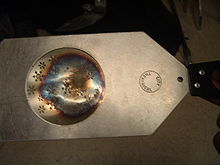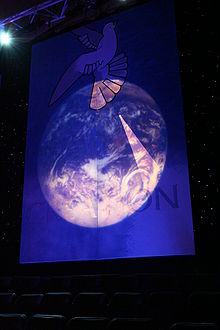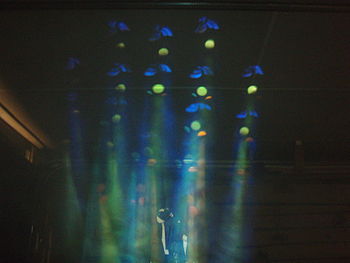- Gobo (lighting)
-
For other uses, see Gobo (disambiguation).A gobo in a gobo holder, which goes in a stage lighting instrument. The discolored portion is oxidation of the stainless steel caused by the high temperature of the lamp, but the gobo is still usable.

A gobo (or GOBO) derived from "Go Between" or Goes Before Optics -originally used on film sets, is a physical template slotted inside, or placed in front of, a lighting source, used to control the shape of emitted light.
In the design of an artificial environment in which lighting instruments are used, it is sometimes desirable to manipulate the shape of the light which is cast over a space or object. To do so, a piece of material with patterned holes through which light passes is placed in the beam of light to allow only the desired "shape" or pattern through, while blocking the rest of the light, casting a specific shadow/light into the space.
Though the term "gobo" has come to generally refer to any device which produces patterns of light and shadow or various pieces of equipment that go before a light (such as a gobo arm or gobo head),[1] the specific term itself also defines the device used in theatrical lighting applications because of the mandated placement of the device in 'the gate' or 'point of focus' between the light source and the lenses (or optics). This placement is important because it allows the focusing of the pattern or shape into a crisp, sharp edge (for logos, fine detail, architecture, etc.) and also the softening the edges (breakup patterns, etc.). On film sets gobos, also known as Flags and "cookies" which are placed in the beam of light post-optics do not have the option of such fine focus.
Contents
Use
A glass gobo of the Earth (Apollo ColourScenic "Earth") projected using an ETC Source Four with an Enhanced Definition Lens Tube (EDLT)
Gobos may be used, in connection with projectors and simpler light sources, to create lighting scenes in a theatrical application. Simple gobos, incorporated into automated lighting systems, are popular at nightclubs and other musical venues to create moving shapes.[2] Gobos may also be used for architectural lighting, as well as in interior design, as in projecting a company logo on a wall or other feature.
A theatrical gobo may be made from either sheet metal or borosilicate glass, depending upon the complexity of the design.
Glass gobos can include colored areas (much like stained glass windows), made of multiple layers of dichroic glass, one for each color glued on an aluminium or chrome coated black and white gobo. New technologies make it possible to turn a color photo into a glass gobo.
In low budget theatre, discarded soda cans or pie plates can be used and patterns cut out with any cutting tool. The latest commercial technology enables finely dithered patterns which give the illusion of shading. In the UK, printer's Lithoplate was widely used as an inexpensive gobo substitute. However, these gobos tend to wear quickly due to the heat produced by a stage lighting instrument and are not viable for most venues.
Plastic gobos—which are generally custom made—are available when a pattern is needed in color and glass does not suffice. However, these thin plastic films generally need to be used with special cooling elements to prevent melting them. A lapse in the cooling apparatus, even for just a few seconds, can cause an expensive gobo to be ruined.
A number of simple and complex stock patterns are manufactured and sold by various theatrical and photographic supply companies, or custom gobos from customer-created images can be manufactured for an additional fee. Generally the lighting designer chooses a pattern from a catalogue or small swatch book provided by the manufacturer. Because of the large number of gobos available, they are generally referred to by number, not name. For example, most manufacturers offer a gobo of a window, but they are all slightly different. So instead of calling it window, it would be identified as gobo 77143 [1]
Mechanics/optics
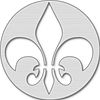
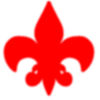
A gobo with the design on the left, with a red gel would project a pattern like the one shown to the right. The gobo is placed in the focal plane of the lantern (generally an ellipsoidal reflector spotlight). The gobo is inserted upside-down and back-to-front. The desired pattern is then projected by the lantern onto whatever surface it is pointed at such as a wall or dance floor.
Gobos can provide everything from abstract dappled light effects to complex night-time cityscapes. They are commonly used in stage lighting, television, and film production to create texture, mood, or set a scene. Specialized attachments are available to rotate multiple gobos in different directions and rates to create an illusion of motion, such as that of light reflected off of moving water.
This effect allows the lighting designer to produce effects to help portray the scene. For example, a gobo with a cloud pattern may be used to suggest a scene is outdoors.
Common Gobo Sizes
Letter Size O.D. (mm) I.A. (mm) Notes C size 150 120 A Size 100 75 B Size 86 64.5 BG Size 79 64.5 M Size 66 48 G Size 65.5 48 For Clay Paky Goldenscans. D Size 53.3 38 Cyberlight 44.25 38 E Size 37.5 28 size t
Studio Spot 575 36.3 31 For HES Studio Spot 575. Mac 500/918 27.5 22 V Size 25.5 22 Mac 250 22.5 17 518 Size 20 13 O.D = Outside Diameter; I.A. = Image Area Other meanings
The derivation "Go-between" is from motion picture production, where gobo is an antiquated term for a what is now called a "flag". Flags are manufactured in a variety of sizes and shapes, are most commonly made of opaque black fabric stretched over a steel frame, but flags can also be made of sheet steel or wood for specialised use. Shaped flags are placed in the beam of a light source in order to create shadows, this type of flag is commonly known as a Gobo.
The support system used to position and hold these flags in the light beam has, as its core component a fully rotatable, adjustable clamp called a gobo head. [2] Gobo heads are mounted at the top of C-Stands and on the ends of 30" long aluminum bars, called Gobo arms or Grip arms.
Gobos are sometimes, incorrectly, known as "Bogos."[citation needed]
See also
References
- World Wide Words - Michael Quinion writes about international English from a British viewpoint.
- ^ Box, Harry C. "Set lighting technician's handbook" Third Edition, Focal Press, 2003. p. 120.
- ^ Edwin Paul J. Tozer (2004). Broadcast engineer's reference book. Focal Press. p. 516. ISBN 9780240519081. http://books.google.com/books?id=DL73f4vFeEwC&pg=PA516&dq=gobo+projector+disco&client=firefox-a#v=onepage&q=gobo%20projector%20disco&f=false.
Stagecraft Theatrical scenery
(Scene shop)FieldsHardwareStage lighting FieldsHardwareBarn doors · Color gel · Color scroller · Cyclorama · Gobo · Lighting control console · Stage pin connector · Top hat · Theatrical fogBeam projector · Ellipsoidal reflector spotlight · Fresnel lantern · Intelligent lighting · Parabolic aluminized reflector light · Scoop · Striplight · AccessoriesOther Fields Categories:- Stage terminology
- Stage lighting
Wikimedia Foundation. 2010.

